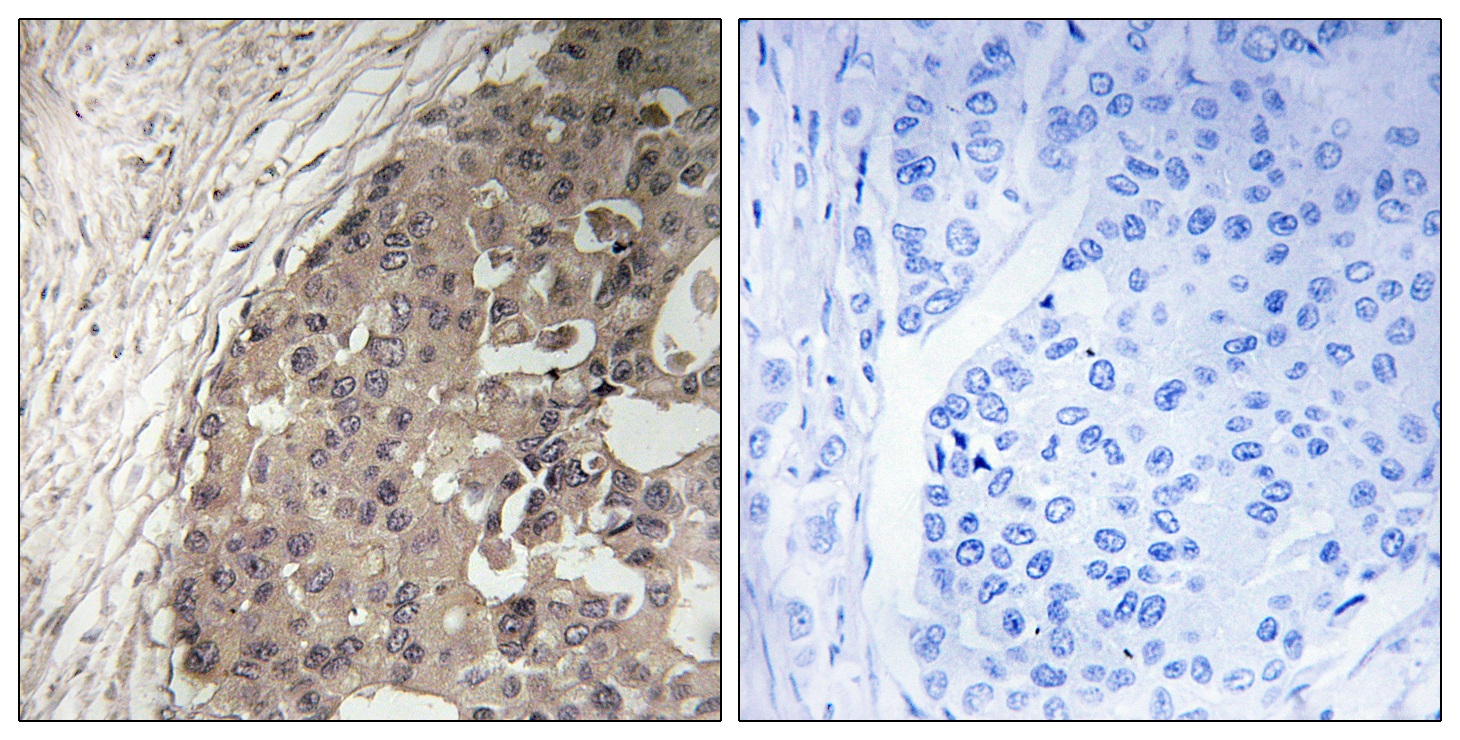β-1,4-GalNAc-T Polyclonal Antibody
- Catalog No.:YT5006
- Applications:WB;IHC;IF;ELISA
- Reactivity:Human;Mouse;Rat
- Target:
- β-1,4-GalNAc-T
- Fields:
- >>Glycosaminoglycan biosynthesis - chondroitin sulfate / dermatan sulfate;>>Metabolic pathways
- Gene Name:
- CSGALNACT1
- Protein Name:
- Chondroitin sulfate N-acetylgalactosaminyltransferase 1
- Human Gene Id:
- 55790
- Human Swiss Prot No:
- Q8TDX6
- Mouse Gene Id:
- 234356
- Mouse Swiss Prot No:
- Q8BJQ9
- Immunogen:
- The antiserum was produced against synthesized peptide derived from human CSGALNACT1. AA range:201-250
- Specificity:
- β-1,4-GalNAc-T Polyclonal Antibody detects endogenous levels of β-1,4-GalNAc-T protein.
- Formulation:
- Liquid in PBS containing 50% glycerol, 0.5% BSA and 0.02% sodium azide.
- Source:
- Polyclonal, Rabbit,IgG
- Dilution:
- WB 1:500 - 1:2000. IHC 1:100 - 1:300. ELISA: 1:40000.. IF 1:50-200
- Purification:
- The antibody was affinity-purified from rabbit antiserum by affinity-chromatography using epitope-specific immunogen.
- Concentration:
- 1 mg/ml
- Storage Stability:
- -15°C to -25°C/1 year(Do not lower than -25°C)
- Other Name:
- CSGALNACT1;CHGN;GALNACT1;Chondroitin sulfate N-acetylgalactosaminyltransferase 1;CsGalNAcT-1;Chondroitin beta-1;4-N-acetylgalactosaminyltransferase 1;Beta4GalNAcT-1
- Observed Band(KD):
- 60kD
- Background:
- catalytic activity:UDP-N-acetyl-D-galactosamine + beta-D-glucuronyl-(1->3)-D-galactosyl-proteoglycan = UDP + N-acetyl-D-galactosaminyl-(1->4)-beta-D-glucuronyl-(1->3)-beta-D-galactosylproteoglycan.,function:Transfers 1,4-N-acetylgalactosamine (GalNAc) from UDP-GalNAc to the non-reducing end of glucuronic acid (GlcUA). Required for addition of the first GalNAc to the core tetrasaccharide linker and for elongation of chondroitin chains. Important role in chondroitin chain biosynthesis in cartilage.,online information:Chondroitin beta-1,4-N-acetylgalactosaminyltransferase 1,online information:GlycoGene database,PTM:N-glycosylated.,similarity:Belongs to the chondroitin N-acetylgalactosaminyltransferase family.,tissue specificity:Ubiquitous, with the highest levels in placenta, thyroid, bladder, prostate and adrenal gland. Detected at low levels in the other tissues examined.,
- Function:
- catalytic activity:UDP-N-acetyl-D-galactosamine + beta-D-glucuronyl-(1->3)-D-galactosyl-proteoglycan = UDP + N-acetyl-D-galactosaminyl-(1->4)-beta-D-glucuronyl-(1->3)-beta-D-galactosylproteoglycan.,function:Transfers 1,4-N-acetylgalactosamine (GalNAc) from UDP-GalNAc to the non-reducing end of glucuronic acid (GlcUA). Required for addition of the first GalNAc to the core tetrasaccharide linker and for elongation of chondroitin chains. Important role in chondroitin chain biosynthesis in cartilage.,online information:Chondroitin beta-1,4-N-acetylgalactosaminyltransferase 1,online information:GlycoGene database,PTM:N-glycosylated.,similarity:Belongs to the chondroitin N-acetylgalactosaminyltransferase family.,tissue specificity:Ubiquitous, with the highest levels in placenta, thyroid, bladder, prostate and adrenal gland. Detected at low levels in the other tissues examined.,
- Subcellular Location:
- Golgi apparatus, Golgi stack membrane ; Single-pass type II membrane protein .
- Expression:
- Ubiquitous, with the highest levels in placenta, thyroid, bladder, prostate and adrenal gland. Detected at low levels in the other tissues examined.
IL-17A and IL-17F repair HIV-1 gp140 damaged Caco-2 cell barriers by upregulating tight junction genes. MICROBES AND INFECTION 2019 Apr 02 WB Human Caco-2 cell
- June 19-2018
- WESTERN IMMUNOBLOTTING PROTOCOL
- June 19-2018
- IMMUNOHISTOCHEMISTRY-PARAFFIN PROTOCOL
- June 19-2018
- IMMUNOFLUORESCENCE PROTOCOL
- September 08-2020
- FLOW-CYTOMEYRT-PROTOCOL
- May 20-2022
- Cell-Based ELISA│解您多样本WB检测之困扰
- July 13-2018
- CELL-BASED-ELISA-PROTOCOL-FOR-ACETYL-PROTEIN
- July 13-2018
- CELL-BASED-ELISA-PROTOCOL-FOR-PHOSPHO-PROTEIN
- July 13-2018
- Antibody-FAQs
- Products Images

- Immunohistochemistry analysis of paraffin-embedded human breast carcinoma tissue, using CSGALNACT1 Antibody. The picture on the right is blocked with the synthesized peptide.



